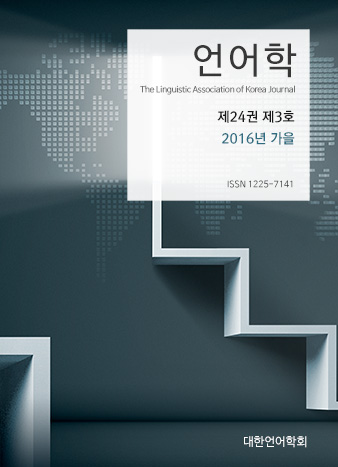대한언어학회 전자저널

Abstract
Lee, Yeunwoo and Park, Kiseong. (2016). The Study of Humor Text Based on Textuality. The Linguistic Association of Korea Journal, 24(3), 207-222. On the basis of the assumption that humor text is a highly context-dependent with reference to the fact that there may be used in linguistic research certain standards of textuality. The purpose of this paper is to explore how the set of standards of textuality is related to humor text. These standards include: cohesion, coherence, intentionality, accepatability, informativity, situationality, and intextuality. This paper shows that the standards can be corresponded to Grice's maxims, and argues that the standards of textuality can be the sub-category of maxims. As a pilot study, we have analyzed some segments of English humor text. The object of this paper are 1) to investigate how the standards of textuality can be arranged as the sub-category of maxims, 2) to examine the correspondence aspects of textuality and maxims, and 3) to argue that humor texts are considered as the texts which have chains of violate certain standards.
Keywords
# 텍스트성 이론(Textuality) # 대화격률(maxims) # 텍스트(text) # 유머(humor) # 대화(communicative) # 추론(inference)
References
- 구현정. (2000). 유머담화의 구조와 생성 기제. 한글, 248, 159-184.
- 국립국어원, “유머”. http://www.korean.go.kr/front/foreignSpell/foreignSpellView.do?forgn_seq=15790&mn_id=96 (2016.06.18.)
- 김태옥 & 이현호. (1995). 담화 연구의 텍스트성 이론과 적합성 이론. 담화와 인지, 1, 1-78.
- 남경완. (2002). 유머 텍스트의 내적 구조와 추론 양상. 텍스트언어학, 13, 295-314.
- 박나리. (2008). 학술논문의 텍스트성 분석: 의도성(intentionality)을 중심으로. 텍스트언어학, 25, 163-192
- 오정은 & 박기성. (2010). 영어 시트콤 담화텍스트상의 유머 생성기제: 체면위협행위와 대화격률 위배를 중심으로. 코기토, 68, 405-427.
- 임지원. (2007). 유머 담화의 생성 기제와 제약 조건: TV 광고문에 나타난 유머를 중심으로. 우리어문연구, 28, 129-157.
- 최영건 & 신현정. (2015). 유머텍스트 처리에서 스키마의 활성화 과정. 한국콘텐츠학회, 15(9), 425-435.
- 한성일. (2002). 유머 텍스트의 사회 언어학적 연구. 사회언어학, 10(1), 339-362.
- 한성일. (2004). 유머 텍스트의 상호텍스트성. 텍스트언어학, 17, 309-332.
- Attardo, S. (1994). Linguistic Theories of Humor. Berlin; New York: Mouton de Gruyter.
- Beaugrande, R. D., & Dressler, W. U. (1981). Introduction to Text Linguistics. London: Longman.
- Grice, P. (1975). Logic and Conversation. In Cole. P. and J. Morgan(eds.), Syntax and Semantics 3: Speech Acts (pp. 41-58). New York: Academic Press.
- Halliday, M. A. K., & Hasan. R. (1976). Cohesion in English. London: Longman.
- Horn, L. (1984). Toward a new taxonomy for pragmatic inference: Q-based and R-based implicative. In: Schiffrin, D. (ed.), Meaning, Form and Use in Contest (p. 11-42). Washington: Georgetown University Press.
- Koestler, A. (1993). Humor and Wit. In McHenry, R. (ed.), Encyclopaedia Britanica 20 (p. 684-685). Chicago: Encyclopaedia Britannica, Inc.
- Mey, J. (1993). Pragmatics: An Introduction. Oxford: Blackwell.
- Neubert, A., & Shreve. G. (1992). Translation as Text. Ohio: Kent State University Press.
- Ross, A. (1998). The language of Humour. London: Routledge.
- Schegloff, E., & H. Sacks. (1973). Opening up Closings. Semiotica, 8, 289-327.
- Sperber, D., & Wilson, D. (1986). Relevance. Oxford: Blackwell.
- Widdowson, H. (1978). Teaching Language as Communication. Oxford: Oxford University Press.
- “The Bigbang Theory.” CBS.com. Columbia Broadcasting System. http://www.cbs.com/shows/big_bang_theory/